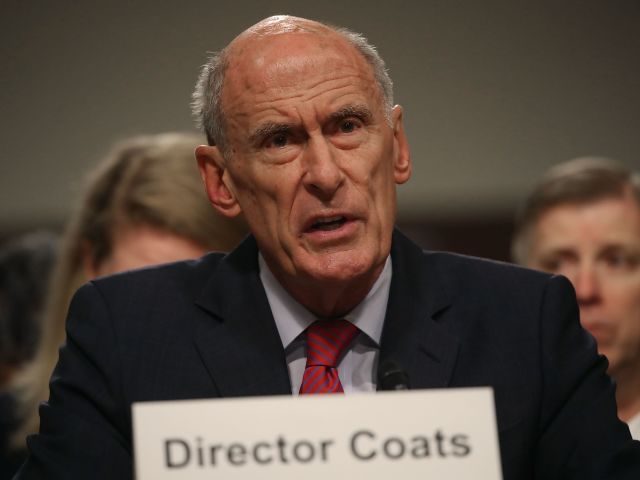The American intelligence community unveiled its annual Worldwide Threat Assessment this week, highlighting the menace to U.S. national security posed by Islamic terrorism, drug overdoses fueled by Mexican and Chinese transnational criminal organizations (TCOs), and various other perils.
During a Senate panel hearing on Tuesday, members of the U.S. Intelligence Community (IC) discussed the yearly analysis authored by the Director of National Intelligence (DNI) with the help of other U.S. government agencies charged with keeping Americans safe.
According to American intelligence analysts, the top threats facing the United States included cyberattacks; jihadist groups such as the Islamic State (ISIS/ISIL) and al-Qaeda; fatal drug overdoses fueled by Latin American and Chinese transnational criminal organizations (TCOs); counterintelligence operations by countries like Iran and Cuba; and Russian and Chinese “counterspace” capabilities, namely antisatellite (ASAT) weapons.
Cyber Threats
Dan Coats, the chief of the Office of the Director of National Intelligence (ODNI), described cybersecurity as one of his top concerns when discussing the threat assessment, telling the Senate Select Committee on Intelligence Tuesday, “Starting with cyber, this is one of my greatest concerns and top priorities.”
In the assessment, American intelligence officials point out:
The potential for surprise in the cyber realm will increase in the next year and beyond as billions more digital devices are connected—with relatively little built-in security—and both nation states and malign actors become more emboldened and better equipped in the use of increasingly widespread cyber toolkits. The risk is growing that some adversaries will conduct cyber attacks—such as data deletion or localized and temporary disruptions of critical infrastructure—against the United States in a crisis short of war.
U.S. intelligence analysts identified Russia, China, Iran, North Korea, as well as terrorists and criminals as the top “adversaries and malign actors poised for” cyber realm “aggression” during the next year.
Islamic Terrorism
The report identifies Islamic extremist groups, mainly Sunni jihadists organizations like the Islamic State (ISIS/ISIL) and al-Qaeda, as “continuing terrorist threats” facing the United States.
Shiite Iran’s narco-terrorist proxy — the Lebanon-based Hezbollah group that maintains a presence in the Western Hemisphere — is also listed as a menace to Americans.
“US-based homegrown violent extremists (HVEs) will remain the most prevalent Sunni violent extremist threat in the United States,” acknowledges the analysis.
U.S. intelligence officials also highlight the use of chemical weapons by ISIS as a threat. Although U.S.-backed fighters and local armed groups have nearly defeated ISIS in its so-called caliphate in Iraq and Syria, the assessment predicts:
Over the next year, we expect that ISIS is likely to focus on regrouping in Iraq and Syria, enhancing its global presence, championing its cause, planning international attacks, and encouraging its members and sympathizers to attack in their home countries. ISIS’s claim of having a functioning caliphate that governs populations is all but thwarted.
More than 16 years after the U.S. launched the ongoing war against al-Qaeda and the Afghan Taliban in response to 9/11, the two groups remain a threat, according to the assessment.
Fatal Drug Overdoses
Mexican and Chinese cartels are fueling the record number of deadly drug overdoses in the United States, declares the Worldwide Threat assessment, echoing President Donald Trump’s National Security Strategy (NSS).
“Transnational organized criminal groups supply the dominant share of illicit drugs consumed in the United States, fueling high mortality rates among US citizens,” notes the assessment, later adding:
Mexican criminal groups will continue to supply much of the heroin, methamphetamine, cocaine, and marijuana that cross the US-Mexico border, while China-based suppliers ship fentanyl and fentanyl precursors to Mexico-, Canada-, and US-based distributors or sell directly to consumers via the Internet.
Using U.S. government data, Breitbart News has determined that the record 64,070 drug-related fatalities across the United States in 2016 more than doubled the total number of worldwide deaths (25,621) at the hands of terrorists that year. Heroin and the synthetic opioid fentanyl have been the top drivers behind the drug overdose epidemic in recent years.
Counterintelligence
U.S. intelligence analysts predict that the U.S. “will face a complex global foreign intelligence threat environment in 2018” at the hands of Russia, China, Iran, and Cuba, among other rivals.
The assessment cautions:
Penetrating the US national decisionmaking apparatus and the Intelligence Community will remain primary objectives for numerous foreign intelligence entities. Additionally, the targeting of national security information and proprietary information from US companies and research institutions involved with defense, energy, finance, dual-use technology, and other areas will remain a persistent threat to US interests.
…
Trusted insiders who disclose sensitive or classified US Government information without authorization will remain a significant threat in 2018 and beyond.
The assessment cites “the 2018 US mid-term elections” as “a potential target for Russian influence operations.”
“Counterspace”
The assessment highlights Russia and China as the top rivals seeking to undermine America’s space capabilities, noting:
Foreign countries—particularly China and Russia—will continue to expand their space-based reconnaissance, communications, and navigation systems in terms of the numbers of satellites, the breadth of their capability, and the applications for use.
Both Russia and China continue to pursue antisatellite (ASAT) weapons as a means to reduce US and allied military effectiveness. Russia and China aim to have nondestructive and destructive counterspace weapons available for use during a potential future conflict.
U.S. intelligence officials expect Russian and Chinese destructive ASAT weapons to be operational “in the next few years.” Experts such as William Carter from the Center for Strategic and International Studies (CSIS) have recently warned lawmakers that ASAT weapons can cripple the U.S. military.

COMMENTS
Please let us know if you're having issues with commenting.